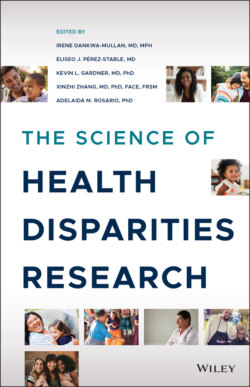Читать книгу The Science of Health Disparities Research - Группа авторов - Страница 68
4.2 Importance of Behavioral Determinants to Minority Health and Health Disparities Research
ОглавлениеBehavioral determinants of health are important because they change health status and outcomes of individuals and populations. In an epidemiological shift, the major causes of death worldwide and in the United States have become noncommunicable diseases. Most prominent are cardiovascular disease, most cancers, chronic respiratory disease, and type 2 diabetes (Figure 4.1) [17]. Eighty‐five percent of the noncommunicable disease mortality rate in some parts of the world, represented by these diseases, can be attributed to four behavioral determinants: tobacco use, physical inactivity, an unhealthy diet, and harmful and excessive use of alcohol. Smoking accounts for most cases of lung cancer, a disease responsible overall for one‐quarter of all US cancer deaths annually (and 40% of cancer deaths in the South) [18], and for chronic respiratory disease, itself linked to lung cancer and heart disease. Diets low in fruits and vegetables and high in trans‐fatty acids and the three s's—sugar, salt, and saturated fats—exacerbated by a sedentary lifestyle and resulting in obesity are associated with such metabolic and physiologic changes as high blood pressure, overweight and obesity, hyperglycemia, and hyperlipidemia, and with decreasing productivity along with shrinking opportunity, including ineligibility for US military service [18].
Figure 4.1 In this illustration of behavioral determinants for noncommunicable disease mortality in low‐ and middle‐income countries, identified by the World Health Organization, four risk factors are linked to 85% of the noncommunicable disease mortality, which is caused by cardiovascular disease, cancer, chronic respiratory disease, and type 2 diabetes.
Source: World Health Organization [17].
Health disparities can grow in minority, rural, and other communities where education, supportive institutions, employment, health engagement, and care access and utilization are in short supply. Organizations, communities, states, or nations—any individuals who band together—in contrast, may have options for structural change through evidence‐based advocacy and legislation.
One area of growing disparities relates to the rapidly evolving opioid epidemic in the United States. An estimated 30 000 people die each year from opioid overdoses [19]. According to the Centers for Disease Control and Prevention, the rate of heroin usage among young white adults increased by 114% from the period 2002–2004 to 2011–2013, and more than 600 000 people died from drug overdoses in the years 2000 to 2016 [20]. Unlike drug epidemics of the past, minority populations have seen less of a rise in drug addiction and death during the opioid epidemic than have young White adults, both male and female [19]. The rise in opioid addiction can be traced to the increased use of prescription pain relievers. In 2012, the number of prescriptions for opioid drugs reached an all‐time high of 259 million [21]. Minorities, especially African Americans and Latinos, are historically underprescribed pain medication [19]. Research has shown that a patient's race or ethnicity is one factor that affects physicians' decisions to prescribe opioids. In a study of emergency room visits, non‐Latino Blacks had significantly lower odds of receiving opioids during visits for back pain and abdominal pain than did non‐Latino Whites [21]. This is backed up by a 2008 study that found that, overall, members of minority groups were less likely than Whites to receive opioids for pain in an emergency department [22].
Failing to address the rapidly increasing prevalence of behavior‐related conditions has financial and health consequences; the challenge of childhood overweight and obesity is a good example. In the past 40 years, the rate of obesity has quadrupled among US children aged 6 to 11 and tripled among adolescents aged 12 to 19 [14]. Most of the burden falls on Latino and African American children, who overall (ages 2 to 19) and in every age segment measured from 2011 to 2014 (ages 2 to 5, ages 6 to 11, and ages 12 to 19) had the highest rates of obesity (15.6–25%), while Asians had the lowest (5.2–9.8%) (Figure 4.2) [11]. Children who are overweight or obese for an extended period are more likely to become overweight or obese adults, who are then more susceptible to heart disease, high blood pressure, and type 2 diabetes. Researchers have found associations between pre‐adulthood obesity and higher risk in adulthood of certain types of cancer. Such findings have prompted calls for more research, including analyses that are more robust across the lifespan [23].
Figure 4.2 Children and adolescents with obesity, overall (2–19 years of age; top, left), and in (following, left to right), generally, preschool, elementary, and secondary school age groups.
Source: US Centers for Disease Control and Prevention [11].
Though annual costs related to childhood obesity are estimated to be $14 billion, annual costs related to adult obesity rise to 10 times that or more ($147–$210 billion). Stigmatizing people with obesity, though a prejudice, is not generally recognized as one and remains largely acceptable in the young and old. Despite its adverse effects on its targets and the generation of health disparities, such prejudice further contributes to chronic burden and medical attention deterrence [24]. Though rapid increases have ended and rates have leveled off, indicators suggest in certain parts of the country disparities are widening because most reductions in obesity rates have occurred in students who are White and from families of higher than average socioeconomic position [14].
We address behavior and other health determinants, including socioeconomics, cultural environment, physical environment, biological and genetic influences, and healthcare, because we value good health for all. By recognizing disparities, we seek to create effective interventions that take into account these influences and to identify and enact policies that support the correction of disparities and the wise use of resources. That is not to suggest that these influences are static. They are dynamic, changing across the lifespan and across generations, and their influence waxes and wanes according to such factors as education, vulnerabilities, environmental stability, and structural drivers (power, income, and other resources) at individual, local, national, and global levels.
